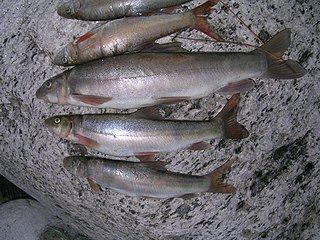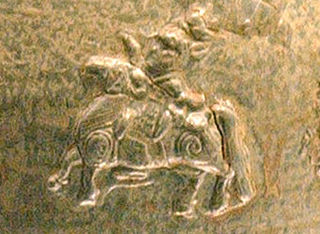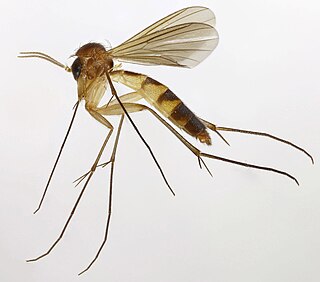
Balantidium is a genus of ciliates. It contains the parasitic species Balantidium coli, the only known cause of balantidiasis.

Jiangshanosaurus is a genus of herbivorous titanosauriform sauropod dinosaur that lived in China approximately 92-88 million years ago, during the Turonian-Coniacian stage of the Late Cretaceous.

Rhinogobius is a genus of primarily freshwater gobies native to tropical and temperate parts of eastern Asia. Most are small, streamlined in shape, and often sexually dimorphic. Few are of commercial importance, but R. duospilus is fairly widely traded as an aquarium fish.

Schizothorax is a genus of cyprinid fish found in southern and western China, through northern South Asia (Himalaya) and Central Asia, to Iran, with a single species, S. prophylax, in Turkey. They are primarily found in highland rivers, streams and lakes, although a few species occur in lower-lying locations, like Lake Balkhash and lakes of the Sistan Basin. Their scientific name means "cloven-breast", from Ancient Greek schízeïn (σχίζειν) 'to cleave' and thórax (θώραξ) 'breast-plate'. The western species are typically referred to as marinkas from their Russian name marinka (маринка), while the eastern species are usually called snowtrout. Although they do resemble trouts in habitus this is merely due to convergent evolution and they are by no means closely related apart from both being Teleostei: Cyprinids are in the teleost superorder Ostariophysi, while trouts are in the superorder Protacanthopterygii. Their ancestors must thus have diverged as early as the Triassic, more than 200 million years ago.
Sinocyclocheilus is a genus of freshwater fish in the family Cyprinidae that is endemic to Guangxi, Guizhou and Yunnan in China. Almost all of its species live in or around caves and most of these have adaptions typical of cavefish such as a lack of scales, lack of pigmentation and reduced eyes. Several species have an unusual hunchbacked appearance and some of the cave-dwellers have a "horn" on the back, the function of which is unclear. In contrast, the Sinocyclocheilus species that live aboveground, as well as a few found underground, show no clear cavefish adaptions. They are relatively small fish reaching up to 23 cm (9.1 in) in length. The individual species have small ranges and populations, leading to the status of most of the evaluated species as threatened. Many species populations in the genus have yet to be evaluated by the IUCN.

Triplophysa is a genus of fish in the family Nemacheilidae found mainly in and around the Qinghai-Tibet Plateau in China, as well as inland waters of the larger part of central Asia. They can be distinguished from other genera of Nemacheilidae by marked sexual dimorphism, including the development of nuptial tubercles on breeding males. Currently, the genus is a mixed assemblage of species. Some lineages have been identified and treated as subgenera, but as Wikipedia follows Fishbase for fish species all but Hedinichthys have been treated as subgenera in Wikipedia, although Kottelat in his revision of the loaches did recognise them as valid. FishBase, however, includes these in Triplophysa without specifying subgenera and treats the names given by Kottelat as synonyms.
Rugosuchus is an extinct genus of neosuchian crocodyliform from the late Early Cretaceous of China. It is known from most of a skull, a partial postcranial skeleton, and a second partial skeleton including part of the hips. It was described by Xiao-Chun Wu and colleagues in 2001, with R. nonganensis as the type species. At the time of its description, it was the most complete crocodyliform from northeastern China, and only the second known.

The Jin dynasty was a major Chinese imperial dynasty. Following the devastation of the Three Kingdoms period, the Jin unified those territories and fostered a brief period of prosperity between 280 and 304 CE. However, during this period many social problems developed as well, the most pressing of which was the migration of non-Han tribes into Jin territory, to the point where they outnumbered the Han people in some regions.

Qin's wars of unification were a series of military campaigns launched in the late 3rd century BC by the state of Qin against the other six powers remaining in China — Han, Zhao, Yan, Wei, Chu and Qi. Between 247 and 221 BC, Qin had developed into one of the most powerful of China's Seven Warring States that coalesced in the wake of the Zhou dynasty's decline, by now retaining a weak and merely ceremonial position among the warring states. In 230 BC, King Ying Zheng of Qin began the sequence of campaigns that would bring the Warring States period to a close, setting out to conquer each remaining sovereign one by one. This was completed in 221 BC with the fall of Qi, leaving the former Zhou sphere unified under a more centralized Qin control. Ying Zheng declared himself the First Emperor, or Qin Shi Huang—becoming the first sovereign over a unified China under the imperial Qin dynasty.
The Discourses on Salt and Iron was a debate held at the imperial court in 81 BCE on state policy during the Han dynasty in China. The previous emperor, Emperor Wu, had reversed the laissez-faire policies of his predecessors and imposed a wide variety of state interventions, such as creating monopolies on China's salt and iron enterprises, price stabilization schemes, and taxes on capital. These actions sparked a fierce debate as to the policies of the Emperor. After his death, during the reign of Emperor Zhao of Han, the regent Huo Guang called on all the scholars of the empire to come to the capital, Chang'an, to debate the government's economic policies.

Houttuynia is a genus of two species in the Saururaceae native to Southeast Asia. One species, H. cordata, is widely cultivated as a culinary herb. The genus was originally described in 1783 by Carl Peter Thunberg when he formally described H. cordata as the only species. It remained a monotypic genus until 2001 when Zheng Yin Zhu and Shi Liang Zhang discovered and described a second species native to China, H. emeiensis but the validity still unestablished. It was named after Dutch naturalist Martinus Houttuyn.
Ingentidens is an extinct genus of chroniosuchid reptiliomorph from upper Permian mudstone deposits of Dashankou locality, Xidagou Formation of China. It was first named by Jin-Ling Li and Zheng-Wu Cheng in 1999, from a mandible. The type species is Ingentidens corridoricus. The generic name means “large” + “tooth” (dens), and the specific name referring to the region of Gansu, the Hexi Corridor where the type specimen was found.
Phratochronis is an extinct genus of chroniosuchid reptiliomorph from upper Permian mudstone deposits of Dashankou locality, Xidagou Formation of China. It was first named by Jin-Ling Li and Zheng-Wu Cheng in 1999, from a maxilla and premaxilla with almost complete dentition. The type species is Phratochronis qilianensis. The generic name means “brothers of a clan” + “late” in reference to its taxonomic position, and the specific name referring to the chain of mountains where the type specimen was found.
Discogobio is a genus of cyprinid fish that are found in eastern Asia. So far the 16 species have only been identified from China and Vietnam wherein each species is endemic to the country in which it is found.
Sinilabeo is a genus of cyprinid freshwater fish found in China and Vietnam.

Diploderma is a genus of lizards in the family Agamidae. Species of Diploderma are native to Myanmar, China, Vietnam, Taiwan, and Japan. Most of the species are found in China, including many endemics.

Exechiopsis is a genus of fungus gnats in the family Mycetophilidae.
Mycolicibacterium agri is a species of bacteria from the phylum Actinomycetota that was first isolated from soil. It is non-pigmented and grows rapidly at 25–45 °C on Ogawa egg medium. It has also been isolated from a human skin infection, and raw milk M. agri is capable of degrading octocrylene.








